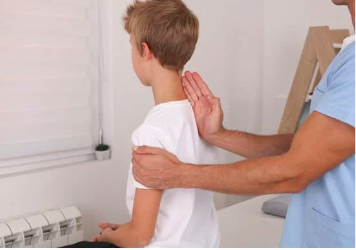
02 Oct Scoliosis
What is Scoliosis?
Scoliosis is the curving and turning of the spines in children and adolescents. It’s most common form is ‘idiopathic scoliosis’ which means we are not sure why it occurs. It is also common in children with neuromuscular disorders such as cerebral palsy. Congenital Scoliosis is bone curvature that has been present since birth. For the purposes of this blog post we will be discussing idiopathic scoliosis.
Who does it present in?
Scoliosis first starts to form between the ages of 10-13 years old. It is most common in females. Often parents first notice scoliosis at the beginning of summer when children start to wear less bulky clothing and spinal curvature becomes more apparent.
Signs to look for?
As parents there are lots of things you can see that may raise concern your child has developed scoliosis. These include:
- Uneven shoulder and pelvis height
- Visible curve in your child’s spine
- Rib cage appears twisted or larger on one side and smaller/thinner on other side
- Head slightly tilted to one side
Symptoms – Whilst most children tend to not notice it initially some children will complain of pain or discomfort, particularly in their upper back.
Testing for Scoliosis?
There are some tests that your doctor or physiotherapist can perform to determine if scoliosis is present and the direction of the curves. This test involves asking your child to bend down to touch their toes with their spine exposed. In this position we can see asymmetries between sides and determine the direction of the curve.
If we suspect scoliosis, we will refer for X-Rays. Which will also help to determine the severity of the curve.
Treatment for Scoliosis?
There are many different treatment options for scoliosis depending on the severity.
Mild scoliosis is usually closely monitored by a doctor or physiotherapist with repeated x-rays done every 6 months. Exercises designed by physiotherapists to help strengthen the core and back muscles can help prevent any development of pain.
Moderate scoliosis who are still growing may benefit from the use of a brace. Braces are worn for majority of the day and are only taken off for showers and exercise. It is important for parents to note that braces will not correct the curve but will prevent progression. Exercises designed by physiotherapists to help strengthen the core and back muscles can help prevent any development of pain.
For children with severe scoliosis referral to an orthopaedic surgeon and likely surgery is recommended. Surgery is only done for the most severe cases where quality of life is significantly impacted. Physiotherapists can help to guide rehabilitation in the community post surgery.
If you have any concerns or questions, please do not hesitate to contact one of our paediatric physiotherapists here at Western Paediatric Physiotherapy.

Sorry, the comment form is closed at this time.